Analysis of GrainCorp's Global Supply Chain Management Challenges
VerifiedAdded on 2020/05/03
|14
|3924
|287
Report
AI Summary
This report provides a comprehensive analysis of GrainCorp's global supply chain management, focusing on the challenges and strategies the company faces. It examines key performance indicators (KPIs) related to cost efficiency, global access, greener operations, and product quality. The report delves into the specific issues GrainCorp encounters, such as high transportation costs, climate change impacts, the need for technological advancements in grain production, and maintaining product quality. Strategies for achieving KPIs are discussed, including maintaining quality through careful crop management, improving cost efficiency through data-driven supplier relationships and automation, enhancing responsiveness via smart supply chains and third-party logistics, and promoting greener operations by reducing waste. The report also touches upon the impact of fuel price fluctuations on supply chain management and the importance of addressing these issues in the context of global logistics. The analysis draws on recent journal articles and real-world examples to illustrate contemporary issues and research in the field of global supply chain management.
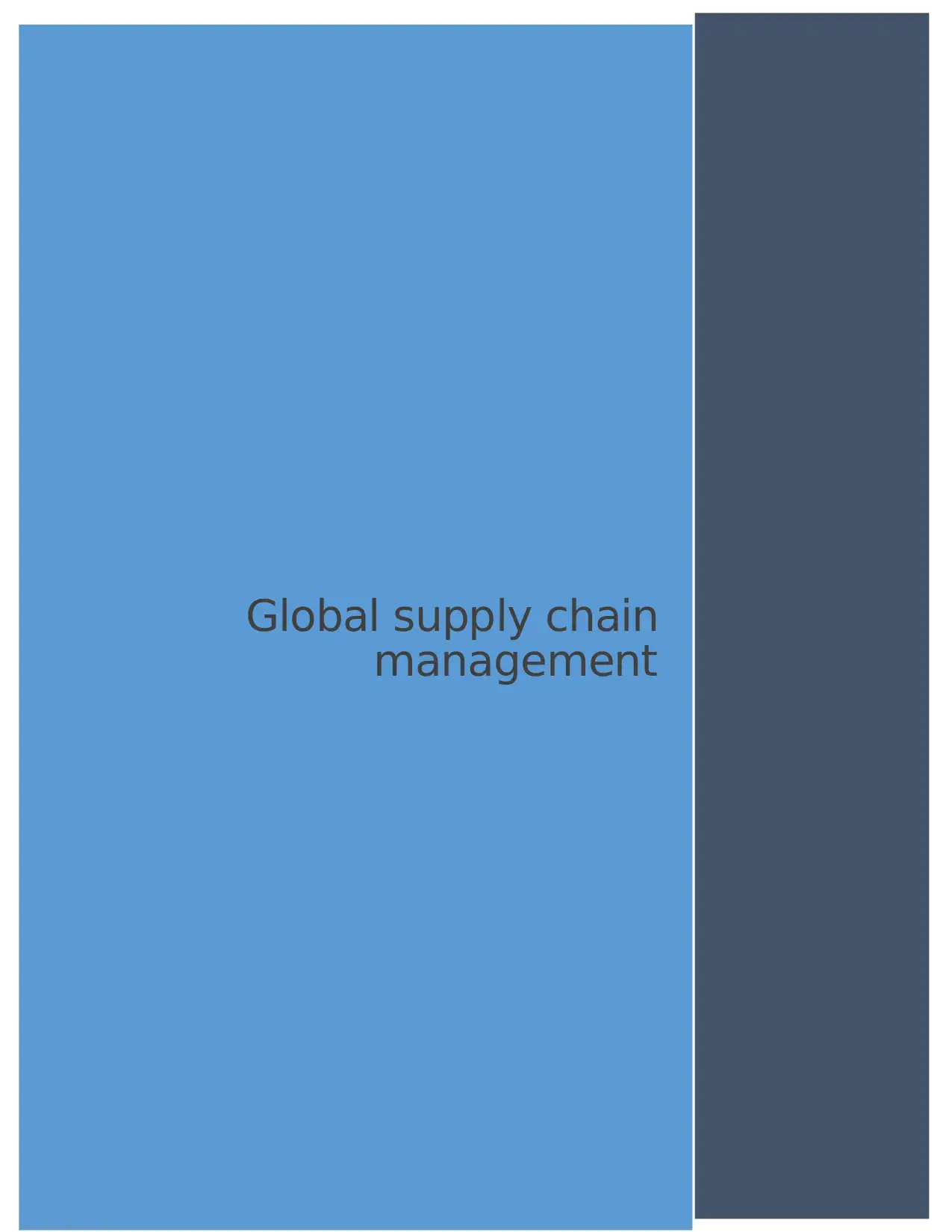
Running head: Supply chain management
Global supply chain
management
Global supply chain
management
Paraphrase This Document
Need a fresh take? Get an instant paraphrase of this document with our AI Paraphraser
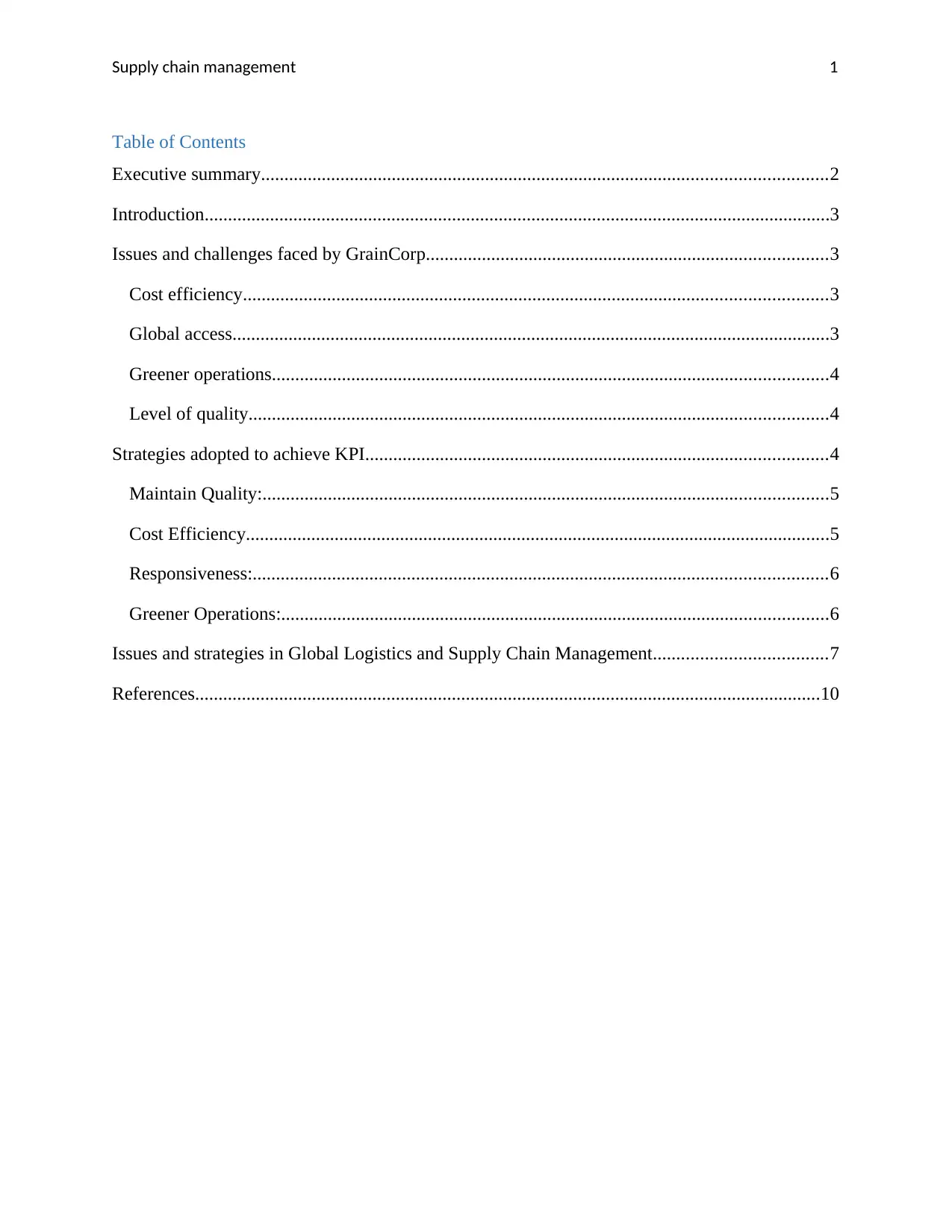
Supply chain management 1
Table of Contents
Executive summary.........................................................................................................................2
Introduction......................................................................................................................................3
Issues and challenges faced by GrainCorp......................................................................................3
Cost efficiency.............................................................................................................................3
Global access................................................................................................................................3
Greener operations.......................................................................................................................4
Level of quality............................................................................................................................4
Strategies adopted to achieve KPI...................................................................................................4
Maintain Quality:.........................................................................................................................5
Cost Efficiency.............................................................................................................................5
Responsiveness:...........................................................................................................................6
Greener Operations:.....................................................................................................................6
Issues and strategies in Global Logistics and Supply Chain Management.....................................7
References......................................................................................................................................10
Table of Contents
Executive summary.........................................................................................................................2
Introduction......................................................................................................................................3
Issues and challenges faced by GrainCorp......................................................................................3
Cost efficiency.............................................................................................................................3
Global access................................................................................................................................3
Greener operations.......................................................................................................................4
Level of quality............................................................................................................................4
Strategies adopted to achieve KPI...................................................................................................4
Maintain Quality:.........................................................................................................................5
Cost Efficiency.............................................................................................................................5
Responsiveness:...........................................................................................................................6
Greener Operations:.....................................................................................................................6
Issues and strategies in Global Logistics and Supply Chain Management.....................................7
References......................................................................................................................................10
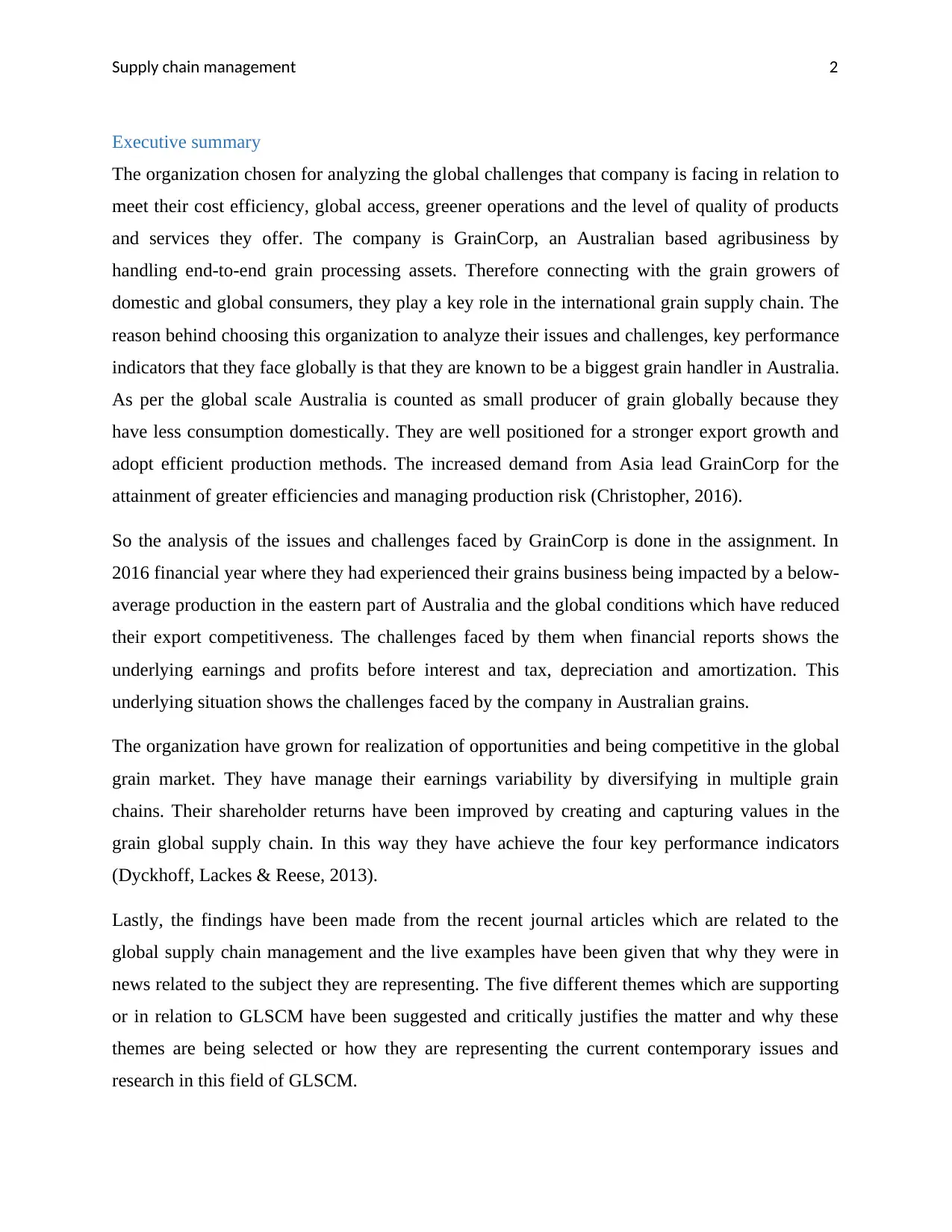
Supply chain management 2
Executive summary
The organization chosen for analyzing the global challenges that company is facing in relation to
meet their cost efficiency, global access, greener operations and the level of quality of products
and services they offer. The company is GrainCorp, an Australian based agribusiness by
handling end-to-end grain processing assets. Therefore connecting with the grain growers of
domestic and global consumers, they play a key role in the international grain supply chain. The
reason behind choosing this organization to analyze their issues and challenges, key performance
indicators that they face globally is that they are known to be a biggest grain handler in Australia.
As per the global scale Australia is counted as small producer of grain globally because they
have less consumption domestically. They are well positioned for a stronger export growth and
adopt efficient production methods. The increased demand from Asia lead GrainCorp for the
attainment of greater efficiencies and managing production risk (Christopher, 2016).
So the analysis of the issues and challenges faced by GrainCorp is done in the assignment. In
2016 financial year where they had experienced their grains business being impacted by a below-
average production in the eastern part of Australia and the global conditions which have reduced
their export competitiveness. The challenges faced by them when financial reports shows the
underlying earnings and profits before interest and tax, depreciation and amortization. This
underlying situation shows the challenges faced by the company in Australian grains.
The organization have grown for realization of opportunities and being competitive in the global
grain market. They have manage their earnings variability by diversifying in multiple grain
chains. Their shareholder returns have been improved by creating and capturing values in the
grain global supply chain. In this way they have achieve the four key performance indicators
(Dyckhoff, Lackes & Reese, 2013).
Lastly, the findings have been made from the recent journal articles which are related to the
global supply chain management and the live examples have been given that why they were in
news related to the subject they are representing. The five different themes which are supporting
or in relation to GLSCM have been suggested and critically justifies the matter and why these
themes are being selected or how they are representing the current contemporary issues and
research in this field of GLSCM.
Executive summary
The organization chosen for analyzing the global challenges that company is facing in relation to
meet their cost efficiency, global access, greener operations and the level of quality of products
and services they offer. The company is GrainCorp, an Australian based agribusiness by
handling end-to-end grain processing assets. Therefore connecting with the grain growers of
domestic and global consumers, they play a key role in the international grain supply chain. The
reason behind choosing this organization to analyze their issues and challenges, key performance
indicators that they face globally is that they are known to be a biggest grain handler in Australia.
As per the global scale Australia is counted as small producer of grain globally because they
have less consumption domestically. They are well positioned for a stronger export growth and
adopt efficient production methods. The increased demand from Asia lead GrainCorp for the
attainment of greater efficiencies and managing production risk (Christopher, 2016).
So the analysis of the issues and challenges faced by GrainCorp is done in the assignment. In
2016 financial year where they had experienced their grains business being impacted by a below-
average production in the eastern part of Australia and the global conditions which have reduced
their export competitiveness. The challenges faced by them when financial reports shows the
underlying earnings and profits before interest and tax, depreciation and amortization. This
underlying situation shows the challenges faced by the company in Australian grains.
The organization have grown for realization of opportunities and being competitive in the global
grain market. They have manage their earnings variability by diversifying in multiple grain
chains. Their shareholder returns have been improved by creating and capturing values in the
grain global supply chain. In this way they have achieve the four key performance indicators
(Dyckhoff, Lackes & Reese, 2013).
Lastly, the findings have been made from the recent journal articles which are related to the
global supply chain management and the live examples have been given that why they were in
news related to the subject they are representing. The five different themes which are supporting
or in relation to GLSCM have been suggested and critically justifies the matter and why these
themes are being selected or how they are representing the current contemporary issues and
research in this field of GLSCM.
⊘ This is a preview!⊘
Do you want full access?
Subscribe today to unlock all pages.

Trusted by 1+ million students worldwide
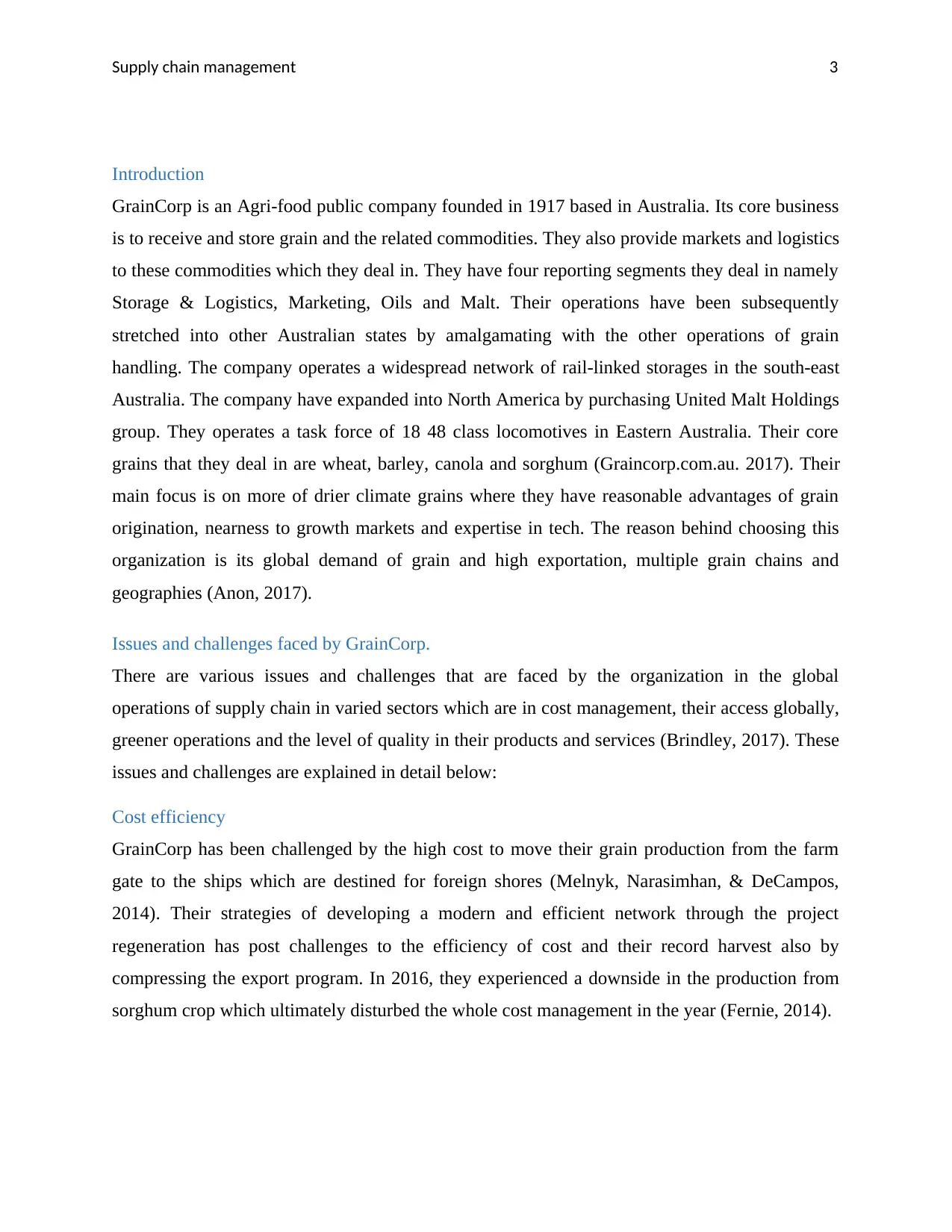
Supply chain management 3
Introduction
GrainCorp is an Agri-food public company founded in 1917 based in Australia. Its core business
is to receive and store grain and the related commodities. They also provide markets and logistics
to these commodities which they deal in. They have four reporting segments they deal in namely
Storage & Logistics, Marketing, Oils and Malt. Their operations have been subsequently
stretched into other Australian states by amalgamating with the other operations of grain
handling. The company operates a widespread network of rail-linked storages in the south-east
Australia. The company have expanded into North America by purchasing United Malt Holdings
group. They operates a task force of 18 48 class locomotives in Eastern Australia. Their core
grains that they deal in are wheat, barley, canola and sorghum (Graincorp.com.au. 2017). Their
main focus is on more of drier climate grains where they have reasonable advantages of grain
origination, nearness to growth markets and expertise in tech. The reason behind choosing this
organization is its global demand of grain and high exportation, multiple grain chains and
geographies (Anon, 2017).
Issues and challenges faced by GrainCorp.
There are various issues and challenges that are faced by the organization in the global
operations of supply chain in varied sectors which are in cost management, their access globally,
greener operations and the level of quality in their products and services (Brindley, 2017). These
issues and challenges are explained in detail below:
Cost efficiency
GrainCorp has been challenged by the high cost to move their grain production from the farm
gate to the ships which are destined for foreign shores (Melnyk, Narasimhan, & DeCampos,
2014). Their strategies of developing a modern and efficient network through the project
regeneration has post challenges to the efficiency of cost and their record harvest also by
compressing the export program. In 2016, they experienced a downside in the production from
sorghum crop which ultimately disturbed the whole cost management in the year (Fernie, 2014).
Introduction
GrainCorp is an Agri-food public company founded in 1917 based in Australia. Its core business
is to receive and store grain and the related commodities. They also provide markets and logistics
to these commodities which they deal in. They have four reporting segments they deal in namely
Storage & Logistics, Marketing, Oils and Malt. Their operations have been subsequently
stretched into other Australian states by amalgamating with the other operations of grain
handling. The company operates a widespread network of rail-linked storages in the south-east
Australia. The company have expanded into North America by purchasing United Malt Holdings
group. They operates a task force of 18 48 class locomotives in Eastern Australia. Their core
grains that they deal in are wheat, barley, canola and sorghum (Graincorp.com.au. 2017). Their
main focus is on more of drier climate grains where they have reasonable advantages of grain
origination, nearness to growth markets and expertise in tech. The reason behind choosing this
organization is its global demand of grain and high exportation, multiple grain chains and
geographies (Anon, 2017).
Issues and challenges faced by GrainCorp.
There are various issues and challenges that are faced by the organization in the global
operations of supply chain in varied sectors which are in cost management, their access globally,
greener operations and the level of quality in their products and services (Brindley, 2017). These
issues and challenges are explained in detail below:
Cost efficiency
GrainCorp has been challenged by the high cost to move their grain production from the farm
gate to the ships which are destined for foreign shores (Melnyk, Narasimhan, & DeCampos,
2014). Their strategies of developing a modern and efficient network through the project
regeneration has post challenges to the efficiency of cost and their record harvest also by
compressing the export program. In 2016, they experienced a downside in the production from
sorghum crop which ultimately disturbed the whole cost management in the year (Fernie, 2014).
Paraphrase This Document
Need a fresh take? Get an instant paraphrase of this document with our AI Paraphraser
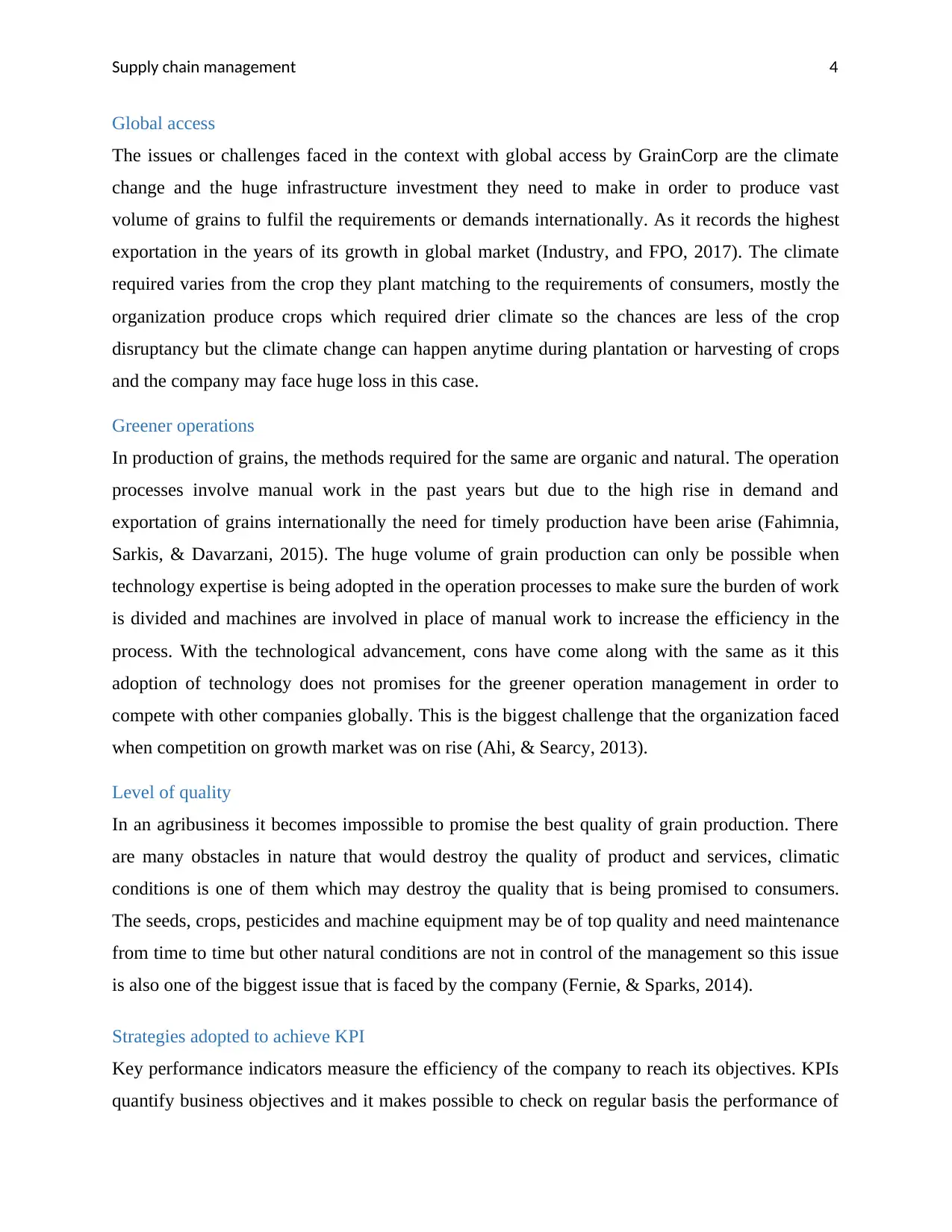
Supply chain management 4
Global access
The issues or challenges faced in the context with global access by GrainCorp are the climate
change and the huge infrastructure investment they need to make in order to produce vast
volume of grains to fulfil the requirements or demands internationally. As it records the highest
exportation in the years of its growth in global market (Industry, and FPO, 2017). The climate
required varies from the crop they plant matching to the requirements of consumers, mostly the
organization produce crops which required drier climate so the chances are less of the crop
disruptancy but the climate change can happen anytime during plantation or harvesting of crops
and the company may face huge loss in this case.
Greener operations
In production of grains, the methods required for the same are organic and natural. The operation
processes involve manual work in the past years but due to the high rise in demand and
exportation of grains internationally the need for timely production have been arise (Fahimnia,
Sarkis, & Davarzani, 2015). The huge volume of grain production can only be possible when
technology expertise is being adopted in the operation processes to make sure the burden of work
is divided and machines are involved in place of manual work to increase the efficiency in the
process. With the technological advancement, cons have come along with the same as it this
adoption of technology does not promises for the greener operation management in order to
compete with other companies globally. This is the biggest challenge that the organization faced
when competition on growth market was on rise (Ahi, & Searcy, 2013).
Level of quality
In an agribusiness it becomes impossible to promise the best quality of grain production. There
are many obstacles in nature that would destroy the quality of product and services, climatic
conditions is one of them which may destroy the quality that is being promised to consumers.
The seeds, crops, pesticides and machine equipment may be of top quality and need maintenance
from time to time but other natural conditions are not in control of the management so this issue
is also one of the biggest issue that is faced by the company (Fernie, & Sparks, 2014).
Strategies adopted to achieve KPI
Key performance indicators measure the efficiency of the company to reach its objectives. KPIs
quantify business objectives and it makes possible to check on regular basis the performance of
Global access
The issues or challenges faced in the context with global access by GrainCorp are the climate
change and the huge infrastructure investment they need to make in order to produce vast
volume of grains to fulfil the requirements or demands internationally. As it records the highest
exportation in the years of its growth in global market (Industry, and FPO, 2017). The climate
required varies from the crop they plant matching to the requirements of consumers, mostly the
organization produce crops which required drier climate so the chances are less of the crop
disruptancy but the climate change can happen anytime during plantation or harvesting of crops
and the company may face huge loss in this case.
Greener operations
In production of grains, the methods required for the same are organic and natural. The operation
processes involve manual work in the past years but due to the high rise in demand and
exportation of grains internationally the need for timely production have been arise (Fahimnia,
Sarkis, & Davarzani, 2015). The huge volume of grain production can only be possible when
technology expertise is being adopted in the operation processes to make sure the burden of work
is divided and machines are involved in place of manual work to increase the efficiency in the
process. With the technological advancement, cons have come along with the same as it this
adoption of technology does not promises for the greener operation management in order to
compete with other companies globally. This is the biggest challenge that the organization faced
when competition on growth market was on rise (Ahi, & Searcy, 2013).
Level of quality
In an agribusiness it becomes impossible to promise the best quality of grain production. There
are many obstacles in nature that would destroy the quality of product and services, climatic
conditions is one of them which may destroy the quality that is being promised to consumers.
The seeds, crops, pesticides and machine equipment may be of top quality and need maintenance
from time to time but other natural conditions are not in control of the management so this issue
is also one of the biggest issue that is faced by the company (Fernie, & Sparks, 2014).
Strategies adopted to achieve KPI
Key performance indicators measure the efficiency of the company to reach its objectives. KPIs
quantify business objectives and it makes possible to check on regular basis the performance of
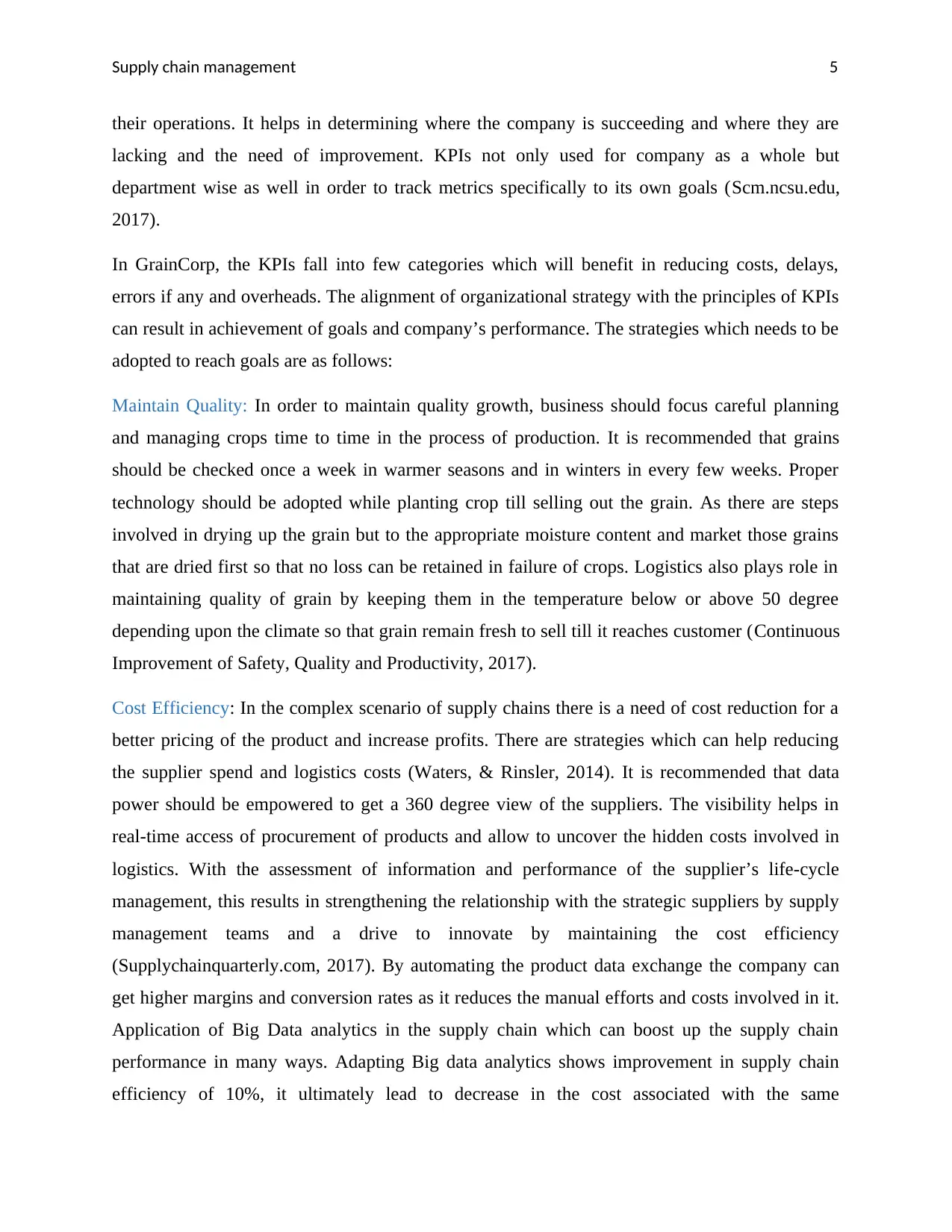
Supply chain management 5
their operations. It helps in determining where the company is succeeding and where they are
lacking and the need of improvement. KPIs not only used for company as a whole but
department wise as well in order to track metrics specifically to its own goals (Scm.ncsu.edu,
2017).
In GrainCorp, the KPIs fall into few categories which will benefit in reducing costs, delays,
errors if any and overheads. The alignment of organizational strategy with the principles of KPIs
can result in achievement of goals and company’s performance. The strategies which needs to be
adopted to reach goals are as follows:
Maintain Quality: In order to maintain quality growth, business should focus careful planning
and managing crops time to time in the process of production. It is recommended that grains
should be checked once a week in warmer seasons and in winters in every few weeks. Proper
technology should be adopted while planting crop till selling out the grain. As there are steps
involved in drying up the grain but to the appropriate moisture content and market those grains
that are dried first so that no loss can be retained in failure of crops. Logistics also plays role in
maintaining quality of grain by keeping them in the temperature below or above 50 degree
depending upon the climate so that grain remain fresh to sell till it reaches customer (Continuous
Improvement of Safety, Quality and Productivity, 2017).
Cost Efficiency: In the complex scenario of supply chains there is a need of cost reduction for a
better pricing of the product and increase profits. There are strategies which can help reducing
the supplier spend and logistics costs (Waters, & Rinsler, 2014). It is recommended that data
power should be empowered to get a 360 degree view of the suppliers. The visibility helps in
real-time access of procurement of products and allow to uncover the hidden costs involved in
logistics. With the assessment of information and performance of the supplier’s life-cycle
management, this results in strengthening the relationship with the strategic suppliers by supply
management teams and a drive to innovate by maintaining the cost efficiency
(Supplychainquarterly.com, 2017). By automating the product data exchange the company can
get higher margins and conversion rates as it reduces the manual efforts and costs involved in it.
Application of Big Data analytics in the supply chain which can boost up the supply chain
performance in many ways. Adapting Big data analytics shows improvement in supply chain
efficiency of 10%, it ultimately lead to decrease in the cost associated with the same
their operations. It helps in determining where the company is succeeding and where they are
lacking and the need of improvement. KPIs not only used for company as a whole but
department wise as well in order to track metrics specifically to its own goals (Scm.ncsu.edu,
2017).
In GrainCorp, the KPIs fall into few categories which will benefit in reducing costs, delays,
errors if any and overheads. The alignment of organizational strategy with the principles of KPIs
can result in achievement of goals and company’s performance. The strategies which needs to be
adopted to reach goals are as follows:
Maintain Quality: In order to maintain quality growth, business should focus careful planning
and managing crops time to time in the process of production. It is recommended that grains
should be checked once a week in warmer seasons and in winters in every few weeks. Proper
technology should be adopted while planting crop till selling out the grain. As there are steps
involved in drying up the grain but to the appropriate moisture content and market those grains
that are dried first so that no loss can be retained in failure of crops. Logistics also plays role in
maintaining quality of grain by keeping them in the temperature below or above 50 degree
depending upon the climate so that grain remain fresh to sell till it reaches customer (Continuous
Improvement of Safety, Quality and Productivity, 2017).
Cost Efficiency: In the complex scenario of supply chains there is a need of cost reduction for a
better pricing of the product and increase profits. There are strategies which can help reducing
the supplier spend and logistics costs (Waters, & Rinsler, 2014). It is recommended that data
power should be empowered to get a 360 degree view of the suppliers. The visibility helps in
real-time access of procurement of products and allow to uncover the hidden costs involved in
logistics. With the assessment of information and performance of the supplier’s life-cycle
management, this results in strengthening the relationship with the strategic suppliers by supply
management teams and a drive to innovate by maintaining the cost efficiency
(Supplychainquarterly.com, 2017). By automating the product data exchange the company can
get higher margins and conversion rates as it reduces the manual efforts and costs involved in it.
Application of Big Data analytics in the supply chain which can boost up the supply chain
performance in many ways. Adapting Big data analytics shows improvement in supply chain
efficiency of 10%, it ultimately lead to decrease in the cost associated with the same
⊘ This is a preview!⊘
Do you want full access?
Subscribe today to unlock all pages.

Trusted by 1+ million students worldwide
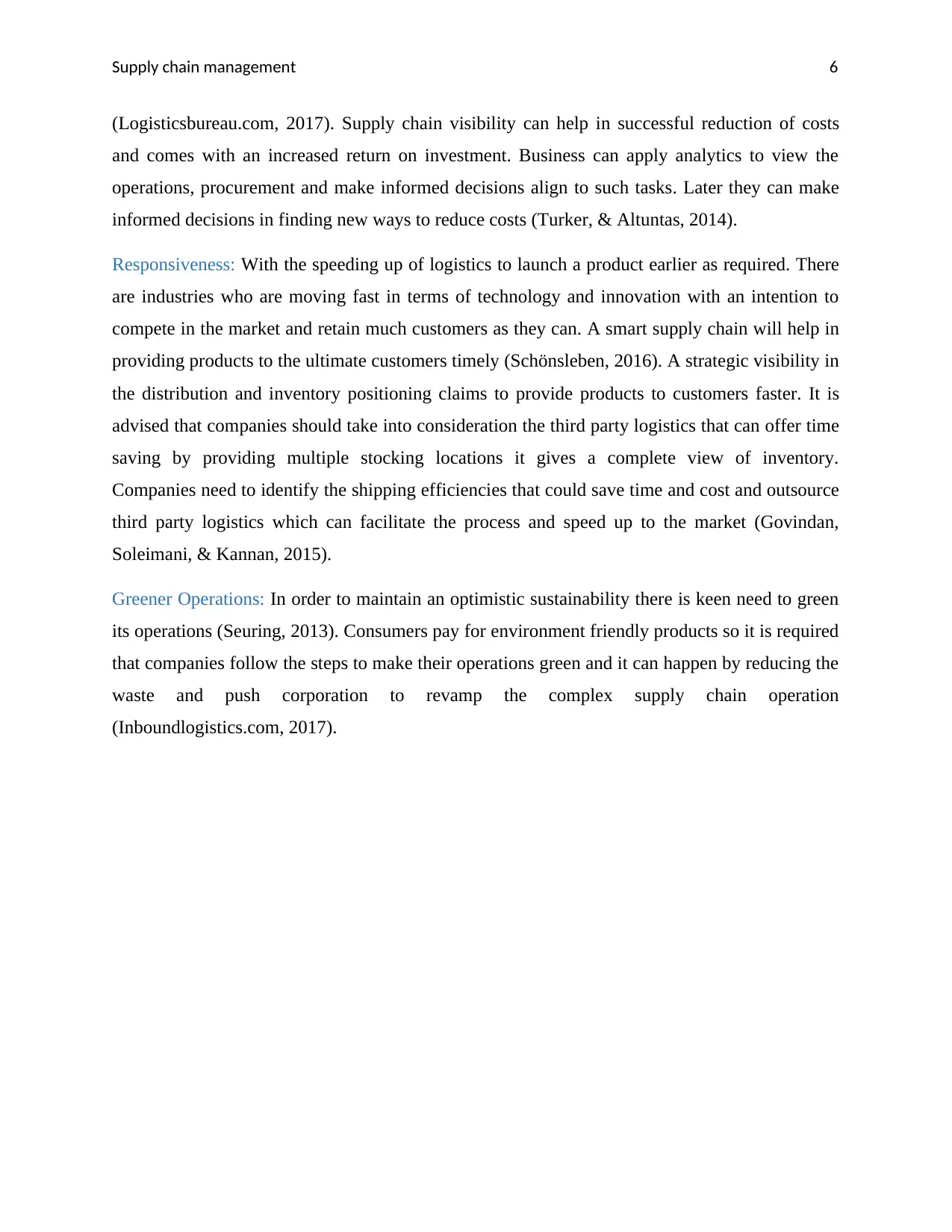
Supply chain management 6
(Logisticsbureau.com, 2017). Supply chain visibility can help in successful reduction of costs
and comes with an increased return on investment. Business can apply analytics to view the
operations, procurement and make informed decisions align to such tasks. Later they can make
informed decisions in finding new ways to reduce costs (Turker, & Altuntas, 2014).
Responsiveness: With the speeding up of logistics to launch a product earlier as required. There
are industries who are moving fast in terms of technology and innovation with an intention to
compete in the market and retain much customers as they can. A smart supply chain will help in
providing products to the ultimate customers timely (Schönsleben, 2016). A strategic visibility in
the distribution and inventory positioning claims to provide products to customers faster. It is
advised that companies should take into consideration the third party logistics that can offer time
saving by providing multiple stocking locations it gives a complete view of inventory.
Companies need to identify the shipping efficiencies that could save time and cost and outsource
third party logistics which can facilitate the process and speed up to the market (Govindan,
Soleimani, & Kannan, 2015).
Greener Operations: In order to maintain an optimistic sustainability there is keen need to green
its operations (Seuring, 2013). Consumers pay for environment friendly products so it is required
that companies follow the steps to make their operations green and it can happen by reducing the
waste and push corporation to revamp the complex supply chain operation
(Inboundlogistics.com, 2017).
(Logisticsbureau.com, 2017). Supply chain visibility can help in successful reduction of costs
and comes with an increased return on investment. Business can apply analytics to view the
operations, procurement and make informed decisions align to such tasks. Later they can make
informed decisions in finding new ways to reduce costs (Turker, & Altuntas, 2014).
Responsiveness: With the speeding up of logistics to launch a product earlier as required. There
are industries who are moving fast in terms of technology and innovation with an intention to
compete in the market and retain much customers as they can. A smart supply chain will help in
providing products to the ultimate customers timely (Schönsleben, 2016). A strategic visibility in
the distribution and inventory positioning claims to provide products to customers faster. It is
advised that companies should take into consideration the third party logistics that can offer time
saving by providing multiple stocking locations it gives a complete view of inventory.
Companies need to identify the shipping efficiencies that could save time and cost and outsource
third party logistics which can facilitate the process and speed up to the market (Govindan,
Soleimani, & Kannan, 2015).
Greener Operations: In order to maintain an optimistic sustainability there is keen need to green
its operations (Seuring, 2013). Consumers pay for environment friendly products so it is required
that companies follow the steps to make their operations green and it can happen by reducing the
waste and push corporation to revamp the complex supply chain operation
(Inboundlogistics.com, 2017).
Paraphrase This Document
Need a fresh take? Get an instant paraphrase of this document with our AI Paraphraser
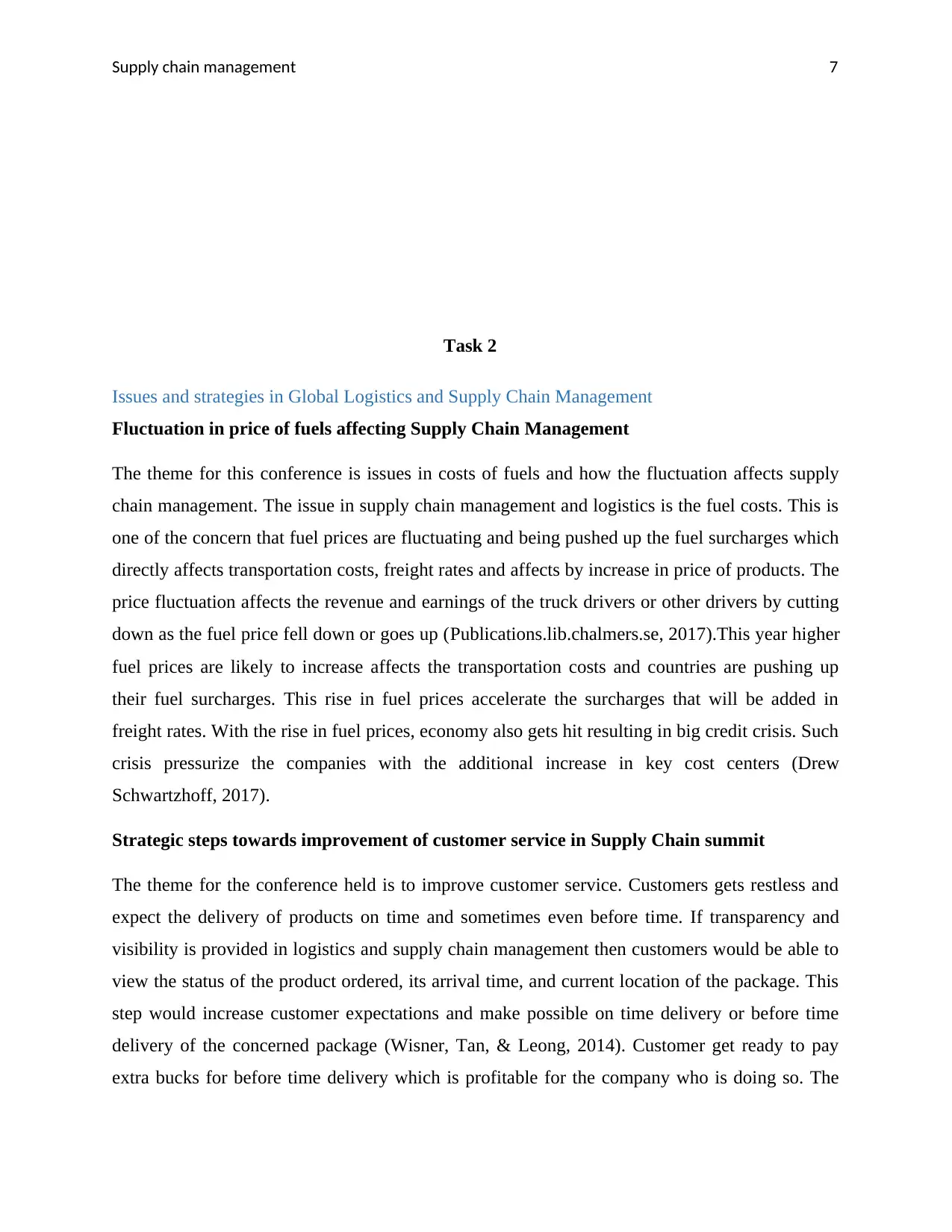
Supply chain management 7
Task 2
Issues and strategies in Global Logistics and Supply Chain Management
Fluctuation in price of fuels affecting Supply Chain Management
The theme for this conference is issues in costs of fuels and how the fluctuation affects supply
chain management. The issue in supply chain management and logistics is the fuel costs. This is
one of the concern that fuel prices are fluctuating and being pushed up the fuel surcharges which
directly affects transportation costs, freight rates and affects by increase in price of products. The
price fluctuation affects the revenue and earnings of the truck drivers or other drivers by cutting
down as the fuel price fell down or goes up (Publications.lib.chalmers.se, 2017).This year higher
fuel prices are likely to increase affects the transportation costs and countries are pushing up
their fuel surcharges. This rise in fuel prices accelerate the surcharges that will be added in
freight rates. With the rise in fuel prices, economy also gets hit resulting in big credit crisis. Such
crisis pressurize the companies with the additional increase in key cost centers (Drew
Schwartzhoff, 2017).
Strategic steps towards improvement of customer service in Supply Chain summit
The theme for the conference held is to improve customer service. Customers gets restless and
expect the delivery of products on time and sometimes even before time. If transparency and
visibility is provided in logistics and supply chain management then customers would be able to
view the status of the product ordered, its arrival time, and current location of the package. This
step would increase customer expectations and make possible on time delivery or before time
delivery of the concerned package (Wisner, Tan, & Leong, 2014). Customer get ready to pay
extra bucks for before time delivery which is profitable for the company who is doing so. The
Task 2
Issues and strategies in Global Logistics and Supply Chain Management
Fluctuation in price of fuels affecting Supply Chain Management
The theme for this conference is issues in costs of fuels and how the fluctuation affects supply
chain management. The issue in supply chain management and logistics is the fuel costs. This is
one of the concern that fuel prices are fluctuating and being pushed up the fuel surcharges which
directly affects transportation costs, freight rates and affects by increase in price of products. The
price fluctuation affects the revenue and earnings of the truck drivers or other drivers by cutting
down as the fuel price fell down or goes up (Publications.lib.chalmers.se, 2017).This year higher
fuel prices are likely to increase affects the transportation costs and countries are pushing up
their fuel surcharges. This rise in fuel prices accelerate the surcharges that will be added in
freight rates. With the rise in fuel prices, economy also gets hit resulting in big credit crisis. Such
crisis pressurize the companies with the additional increase in key cost centers (Drew
Schwartzhoff, 2017).
Strategic steps towards improvement of customer service in Supply Chain summit
The theme for the conference held is to improve customer service. Customers gets restless and
expect the delivery of products on time and sometimes even before time. If transparency and
visibility is provided in logistics and supply chain management then customers would be able to
view the status of the product ordered, its arrival time, and current location of the package. This
step would increase customer expectations and make possible on time delivery or before time
delivery of the concerned package (Wisner, Tan, & Leong, 2014). Customer get ready to pay
extra bucks for before time delivery which is profitable for the company who is doing so. The
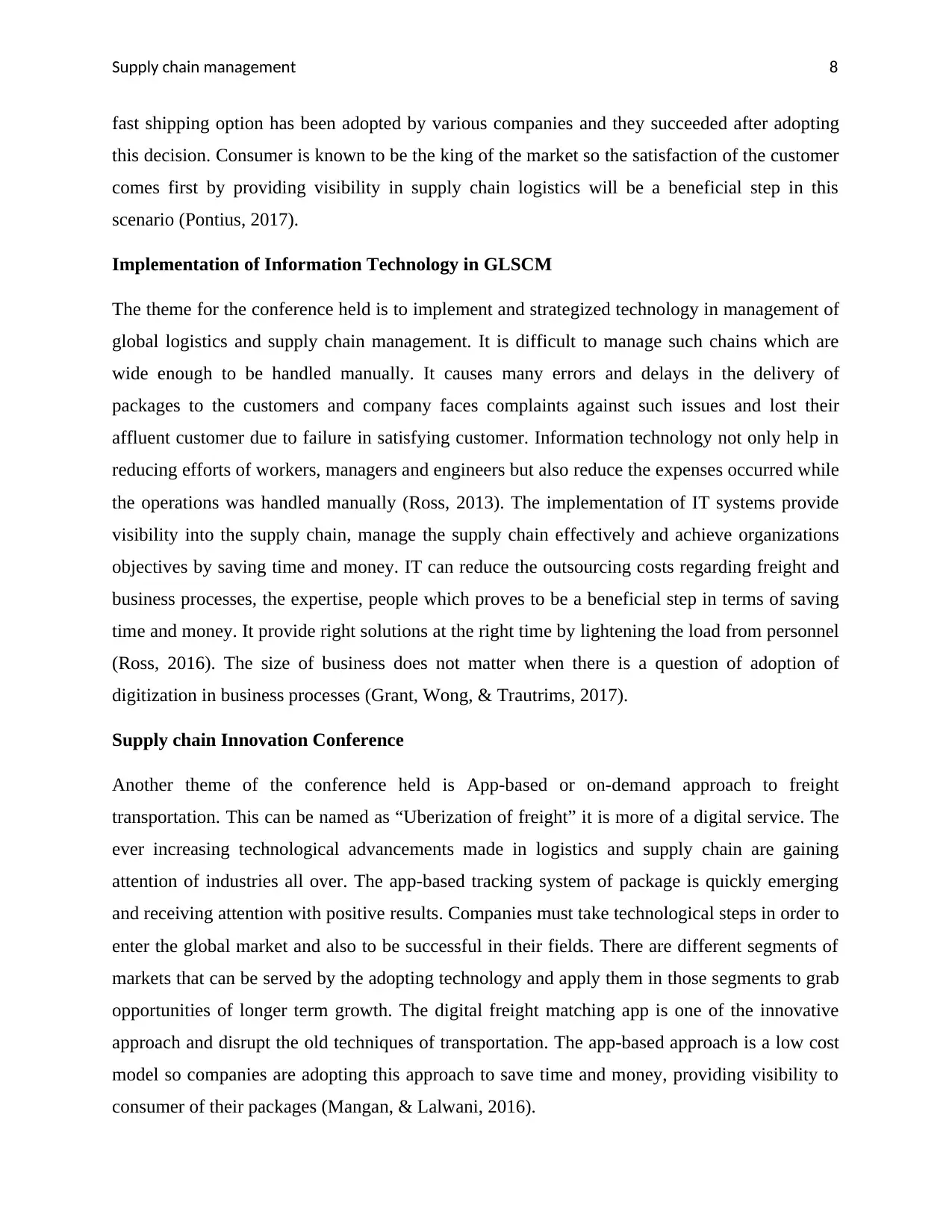
Supply chain management 8
fast shipping option has been adopted by various companies and they succeeded after adopting
this decision. Consumer is known to be the king of the market so the satisfaction of the customer
comes first by providing visibility in supply chain logistics will be a beneficial step in this
scenario (Pontius, 2017).
Implementation of Information Technology in GLSCM
The theme for the conference held is to implement and strategized technology in management of
global logistics and supply chain management. It is difficult to manage such chains which are
wide enough to be handled manually. It causes many errors and delays in the delivery of
packages to the customers and company faces complaints against such issues and lost their
affluent customer due to failure in satisfying customer. Information technology not only help in
reducing efforts of workers, managers and engineers but also reduce the expenses occurred while
the operations was handled manually (Ross, 2013). The implementation of IT systems provide
visibility into the supply chain, manage the supply chain effectively and achieve organizations
objectives by saving time and money. IT can reduce the outsourcing costs regarding freight and
business processes, the expertise, people which proves to be a beneficial step in terms of saving
time and money. It provide right solutions at the right time by lightening the load from personnel
(Ross, 2016). The size of business does not matter when there is a question of adoption of
digitization in business processes (Grant, Wong, & Trautrims, 2017).
Supply chain Innovation Conference
Another theme of the conference held is App-based or on-demand approach to freight
transportation. This can be named as “Uberization of freight” it is more of a digital service. The
ever increasing technological advancements made in logistics and supply chain are gaining
attention of industries all over. The app-based tracking system of package is quickly emerging
and receiving attention with positive results. Companies must take technological steps in order to
enter the global market and also to be successful in their fields. There are different segments of
markets that can be served by the adopting technology and apply them in those segments to grab
opportunities of longer term growth. The digital freight matching app is one of the innovative
approach and disrupt the old techniques of transportation. The app-based approach is a low cost
model so companies are adopting this approach to save time and money, providing visibility to
consumer of their packages (Mangan, & Lalwani, 2016).
fast shipping option has been adopted by various companies and they succeeded after adopting
this decision. Consumer is known to be the king of the market so the satisfaction of the customer
comes first by providing visibility in supply chain logistics will be a beneficial step in this
scenario (Pontius, 2017).
Implementation of Information Technology in GLSCM
The theme for the conference held is to implement and strategized technology in management of
global logistics and supply chain management. It is difficult to manage such chains which are
wide enough to be handled manually. It causes many errors and delays in the delivery of
packages to the customers and company faces complaints against such issues and lost their
affluent customer due to failure in satisfying customer. Information technology not only help in
reducing efforts of workers, managers and engineers but also reduce the expenses occurred while
the operations was handled manually (Ross, 2013). The implementation of IT systems provide
visibility into the supply chain, manage the supply chain effectively and achieve organizations
objectives by saving time and money. IT can reduce the outsourcing costs regarding freight and
business processes, the expertise, people which proves to be a beneficial step in terms of saving
time and money. It provide right solutions at the right time by lightening the load from personnel
(Ross, 2016). The size of business does not matter when there is a question of adoption of
digitization in business processes (Grant, Wong, & Trautrims, 2017).
Supply chain Innovation Conference
Another theme of the conference held is App-based or on-demand approach to freight
transportation. This can be named as “Uberization of freight” it is more of a digital service. The
ever increasing technological advancements made in logistics and supply chain are gaining
attention of industries all over. The app-based tracking system of package is quickly emerging
and receiving attention with positive results. Companies must take technological steps in order to
enter the global market and also to be successful in their fields. There are different segments of
markets that can be served by the adopting technology and apply them in those segments to grab
opportunities of longer term growth. The digital freight matching app is one of the innovative
approach and disrupt the old techniques of transportation. The app-based approach is a low cost
model so companies are adopting this approach to save time and money, providing visibility to
consumer of their packages (Mangan, & Lalwani, 2016).
⊘ This is a preview!⊘
Do you want full access?
Subscribe today to unlock all pages.

Trusted by 1+ million students worldwide
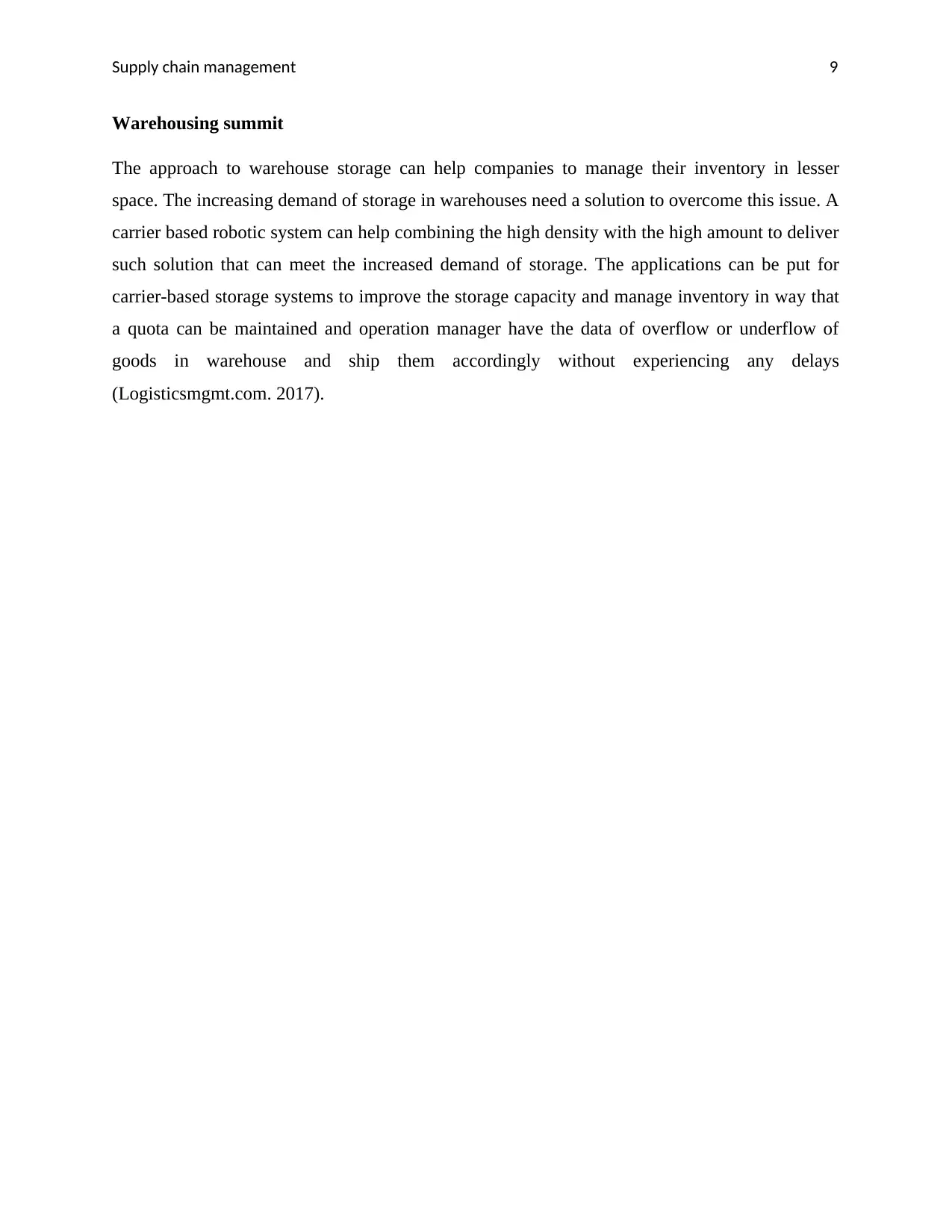
Supply chain management 9
Warehousing summit
The approach to warehouse storage can help companies to manage their inventory in lesser
space. The increasing demand of storage in warehouses need a solution to overcome this issue. A
carrier based robotic system can help combining the high density with the high amount to deliver
such solution that can meet the increased demand of storage. The applications can be put for
carrier-based storage systems to improve the storage capacity and manage inventory in way that
a quota can be maintained and operation manager have the data of overflow or underflow of
goods in warehouse and ship them accordingly without experiencing any delays
(Logisticsmgmt.com. 2017).
Warehousing summit
The approach to warehouse storage can help companies to manage their inventory in lesser
space. The increasing demand of storage in warehouses need a solution to overcome this issue. A
carrier based robotic system can help combining the high density with the high amount to deliver
such solution that can meet the increased demand of storage. The applications can be put for
carrier-based storage systems to improve the storage capacity and manage inventory in way that
a quota can be maintained and operation manager have the data of overflow or underflow of
goods in warehouse and ship them accordingly without experiencing any delays
(Logisticsmgmt.com. 2017).
Paraphrase This Document
Need a fresh take? Get an instant paraphrase of this document with our AI Paraphraser
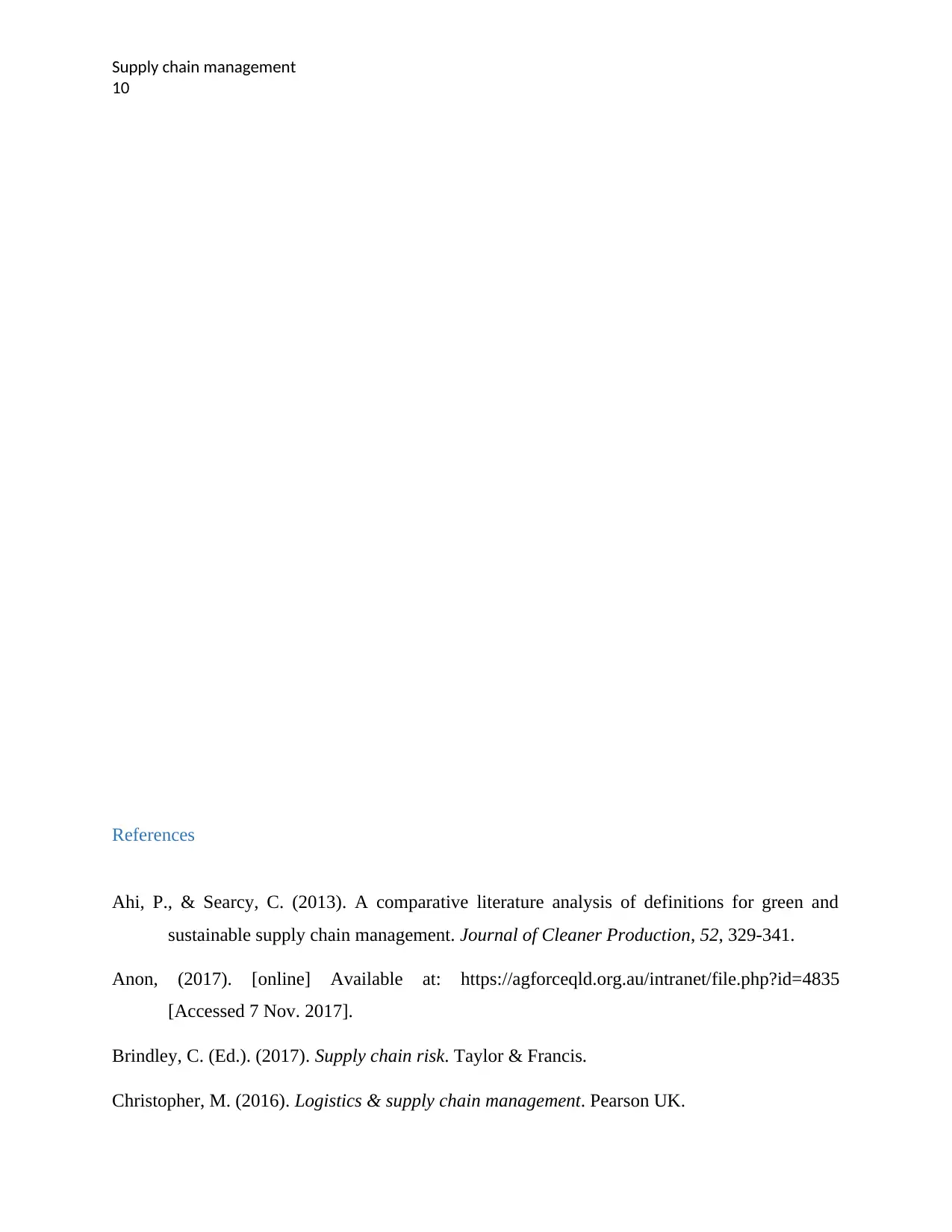
Supply chain management
10
References
Ahi, P., & Searcy, C. (2013). A comparative literature analysis of definitions for green and
sustainable supply chain management. Journal of Cleaner Production, 52, 329-341.
Anon, (2017). [online] Available at: https://agforceqld.org.au/intranet/file.php?id=4835
[Accessed 7 Nov. 2017].
Brindley, C. (Ed.). (2017). Supply chain risk. Taylor & Francis.
Christopher, M. (2016). Logistics & supply chain management. Pearson UK.
10
References
Ahi, P., & Searcy, C. (2013). A comparative literature analysis of definitions for green and
sustainable supply chain management. Journal of Cleaner Production, 52, 329-341.
Anon, (2017). [online] Available at: https://agforceqld.org.au/intranet/file.php?id=4835
[Accessed 7 Nov. 2017].
Brindley, C. (Ed.). (2017). Supply chain risk. Taylor & Francis.
Christopher, M. (2016). Logistics & supply chain management. Pearson UK.
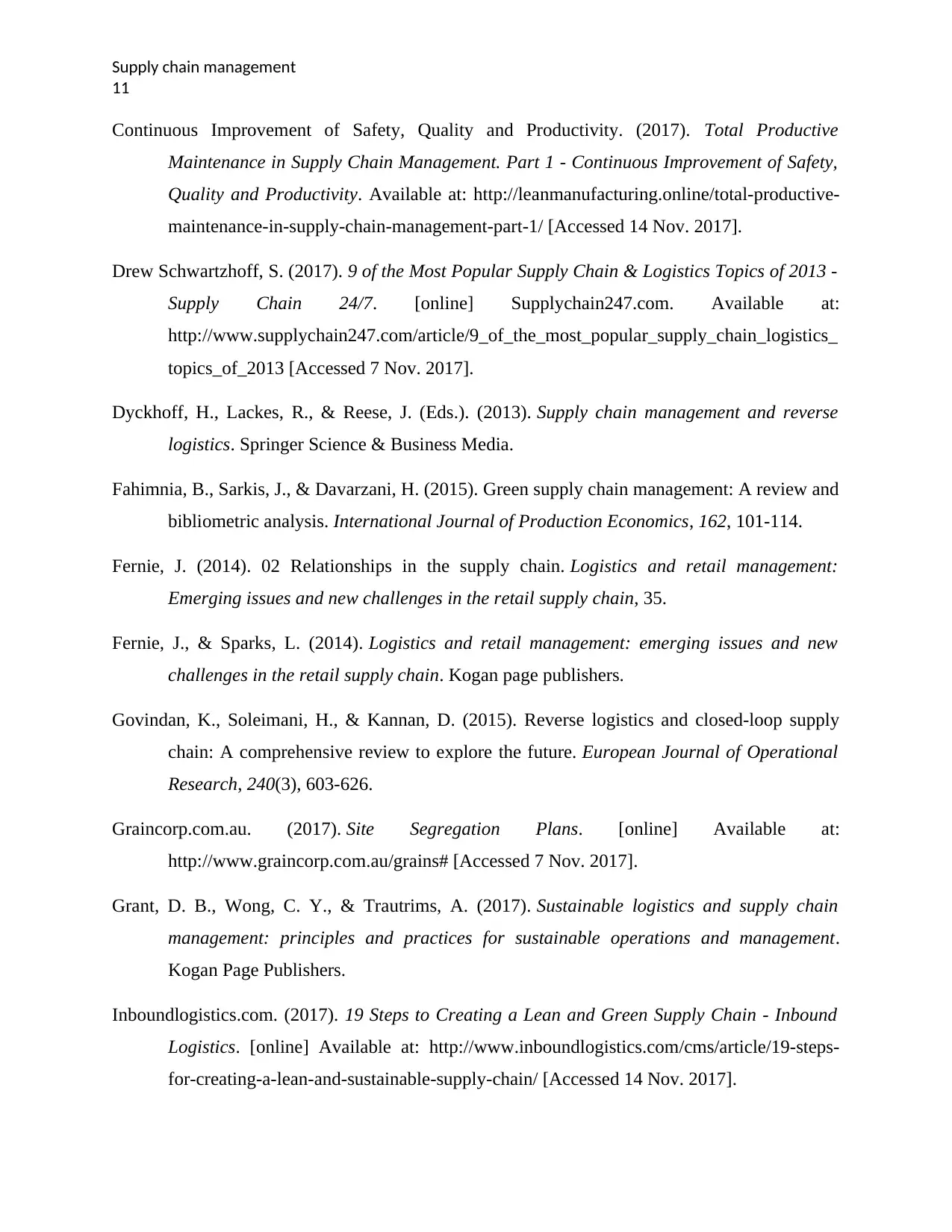
Supply chain management
11
Continuous Improvement of Safety, Quality and Productivity. (2017). Total Productive
Maintenance in Supply Chain Management. Part 1 - Continuous Improvement of Safety,
Quality and Productivity. Available at: http://leanmanufacturing.online/total-productive-
maintenance-in-supply-chain-management-part-1/ [Accessed 14 Nov. 2017].
Drew Schwartzhoff, S. (2017). 9 of the Most Popular Supply Chain & Logistics Topics of 2013 -
Supply Chain 24/7. [online] Supplychain247.com. Available at:
http://www.supplychain247.com/article/9_of_the_most_popular_supply_chain_logistics_
topics_of_2013 [Accessed 7 Nov. 2017].
Dyckhoff, H., Lackes, R., & Reese, J. (Eds.). (2013). Supply chain management and reverse
logistics. Springer Science & Business Media.
Fahimnia, B., Sarkis, J., & Davarzani, H. (2015). Green supply chain management: A review and
bibliometric analysis. International Journal of Production Economics, 162, 101-114.
Fernie, J. (2014). 02 Relationships in the supply chain. Logistics and retail management:
Emerging issues and new challenges in the retail supply chain, 35.
Fernie, J., & Sparks, L. (2014). Logistics and retail management: emerging issues and new
challenges in the retail supply chain. Kogan page publishers.
Govindan, K., Soleimani, H., & Kannan, D. (2015). Reverse logistics and closed-loop supply
chain: A comprehensive review to explore the future. European Journal of Operational
Research, 240(3), 603-626.
Graincorp.com.au. (2017). Site Segregation Plans. [online] Available at:
http://www.graincorp.com.au/grains# [Accessed 7 Nov. 2017].
Grant, D. B., Wong, C. Y., & Trautrims, A. (2017). Sustainable logistics and supply chain
management: principles and practices for sustainable operations and management.
Kogan Page Publishers.
Inboundlogistics.com. (2017). 19 Steps to Creating a Lean and Green Supply Chain - Inbound
Logistics. [online] Available at: http://www.inboundlogistics.com/cms/article/19-steps-
for-creating-a-lean-and-sustainable-supply-chain/ [Accessed 14 Nov. 2017].
11
Continuous Improvement of Safety, Quality and Productivity. (2017). Total Productive
Maintenance in Supply Chain Management. Part 1 - Continuous Improvement of Safety,
Quality and Productivity. Available at: http://leanmanufacturing.online/total-productive-
maintenance-in-supply-chain-management-part-1/ [Accessed 14 Nov. 2017].
Drew Schwartzhoff, S. (2017). 9 of the Most Popular Supply Chain & Logistics Topics of 2013 -
Supply Chain 24/7. [online] Supplychain247.com. Available at:
http://www.supplychain247.com/article/9_of_the_most_popular_supply_chain_logistics_
topics_of_2013 [Accessed 7 Nov. 2017].
Dyckhoff, H., Lackes, R., & Reese, J. (Eds.). (2013). Supply chain management and reverse
logistics. Springer Science & Business Media.
Fahimnia, B., Sarkis, J., & Davarzani, H. (2015). Green supply chain management: A review and
bibliometric analysis. International Journal of Production Economics, 162, 101-114.
Fernie, J. (2014). 02 Relationships in the supply chain. Logistics and retail management:
Emerging issues and new challenges in the retail supply chain, 35.
Fernie, J., & Sparks, L. (2014). Logistics and retail management: emerging issues and new
challenges in the retail supply chain. Kogan page publishers.
Govindan, K., Soleimani, H., & Kannan, D. (2015). Reverse logistics and closed-loop supply
chain: A comprehensive review to explore the future. European Journal of Operational
Research, 240(3), 603-626.
Graincorp.com.au. (2017). Site Segregation Plans. [online] Available at:
http://www.graincorp.com.au/grains# [Accessed 7 Nov. 2017].
Grant, D. B., Wong, C. Y., & Trautrims, A. (2017). Sustainable logistics and supply chain
management: principles and practices for sustainable operations and management.
Kogan Page Publishers.
Inboundlogistics.com. (2017). 19 Steps to Creating a Lean and Green Supply Chain - Inbound
Logistics. [online] Available at: http://www.inboundlogistics.com/cms/article/19-steps-
for-creating-a-lean-and-sustainable-supply-chain/ [Accessed 14 Nov. 2017].
⊘ This is a preview!⊘
Do you want full access?
Subscribe today to unlock all pages.

Trusted by 1+ million students worldwide
1 out of 14
Related Documents
Your All-in-One AI-Powered Toolkit for Academic Success.
+13062052269
info@desklib.com
Available 24*7 on WhatsApp / Email
![[object Object]](/_next/static/media/star-bottom.7253800d.svg)
Unlock your academic potential
Copyright © 2020–2025 A2Z Services. All Rights Reserved. Developed and managed by ZUCOL.





